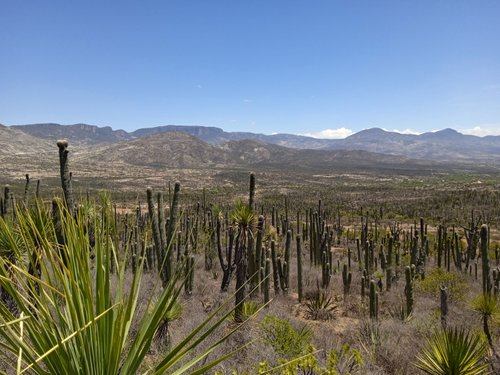
Paisaje desértico, Valle de Tehuacán/Desertic landscape, Tehuacán Valley
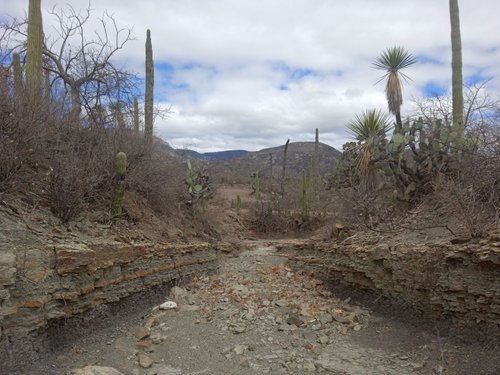
Lecho de un arroyo seco en Tehuacán/Dry creek bed at Tehuacán

Cactus barriliforme con suculecia extrema/Barrel cactus with extreme succulence
Suculencia
La suculencia es una de las adaptaciones a la sequía más llamativas que presentan las plantas. El desarrollo de estructuras carnosas les permite almacenar grandes cantidades de agua en las épocas de lluvia y luego sobrevivir largos períodos de sequía. Esta adaptación usualmente viene acompañada de un sistema metabólico que permite a las pantas almacenar carbono en sus tejidos durante la noche. De esta manera la planta puede realizar fotosíntesis durante el día sin necesidad de intercambiar gases y de esta forma evitar la pérdida de agua durante los momentos más calurosos y secos. A este tipo de metabolismo se le llama CAM, Metabolismo Ácido de las Crasuláceas (siglas en inglés).Succulence
Succulence is one of the most striking adaptations to drought in plants. The development of fleshy structures allows them to store large amounts of water during the rainy season and then survive long periods of drought. This adaptation is usually accompanied by a metabolic system that allows plants to store carbon in their tissues during the night. In this way the plant can photosynthesize during the day without the need to exchange gases and thus avoid water loss during the hottest and driest times. This type of metabolism is called CAM, Crassulacean Acid Metabolism.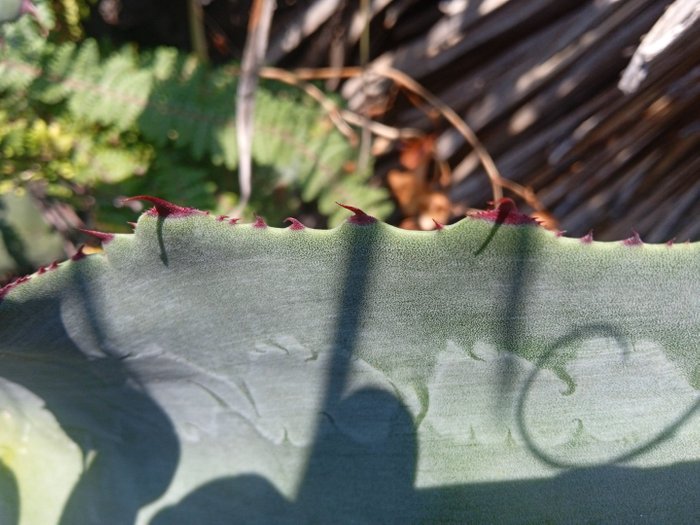
Fragmento de agave con cera/Agave leaf with wax
Secreción de ceras
La prioridad de los organismos en condiciones desérticas es evitar la pérdida de agua, pero esto resulta en estremo difícil para aquellos organismos que deben resistir la radiación solar. En ocasiones evitar el intercambio de gases en horas de sol puede no ser suficiente para evitar esa pérdida. Es por eso que algunas especies desarrollan adaptaciones adicionales como la secreción de ceras que crean una capa adicional de aislamiento.Wax secretion
The priority for organisms in desert conditions is to avoid water loss, but this is extremely difficult for those organisms that must resist solar radiation. Sometimes avoiding gas exchange during sunlight hours may not be enough to prevent water loss. That is why some species develop additional adaptations such as the secretion of waxes that create an additional layer of insulation.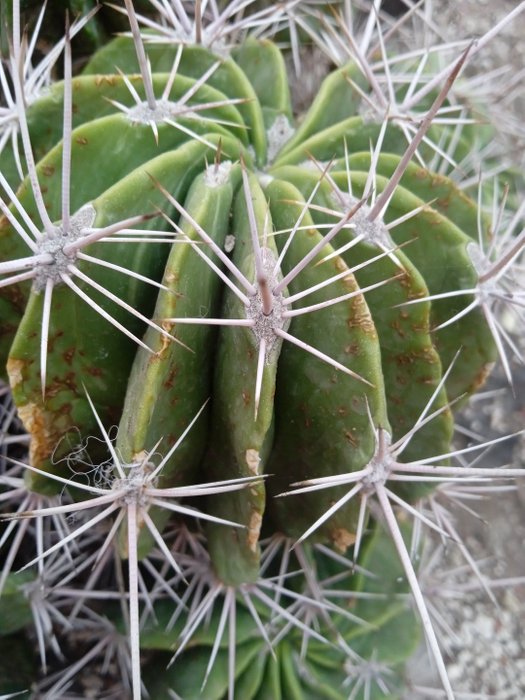
Hojas reducidas a espinas/Leaves reduced to thorns
Espinescencia
Otra de las adaptaciones a la sequía y quizás de las más conocidas es la reducción de las hojas hasta formar espinas. Esta adaptación permite la reducción del área de la planta capaz de transpirar y reduce el porcentaje de la planta exuesta a la luz solar, de manera que se reduce la pérdida de agua.Spinescence
Another of the adaptations to drought and perhaps one of the best known is the reduction of leaves to form thorns. This adaptation allows the reduction of the area of the plant capable of transpiration and reduces the percentage of the plant exposed to sunlight, thus reducing water loss.
Árbol en flor con ausencia total de hojas/Tree in full bloom with total absence of leaves.
Defoliación
Otras especies se han adaptado a las condiciones de sequía utiizando más bien una estrategia de "escape". Esta consiste en perder completamente sus hojas durante el período seco. De esta forma reducen el área de evapo-transpiración. Por otra parte, en esta época reducen también su actividad metabólica, por lo que suelen ser plantas de crecimiento lento. Sin embargo, son capaces de desarrollar hojas en muy corto tiempo cuando llueve.Defoliation
Other species have adapted to drought conditions by using an "escape" strategy. This consists of completely losing their leaves during the dry period. In this way they reduce the area of evapotranspiration. Moreover, they also reduce their metabolic activity at this time, so they are usually slow-growing plants. However, they are capable of developing leaves in a very short time when it rains.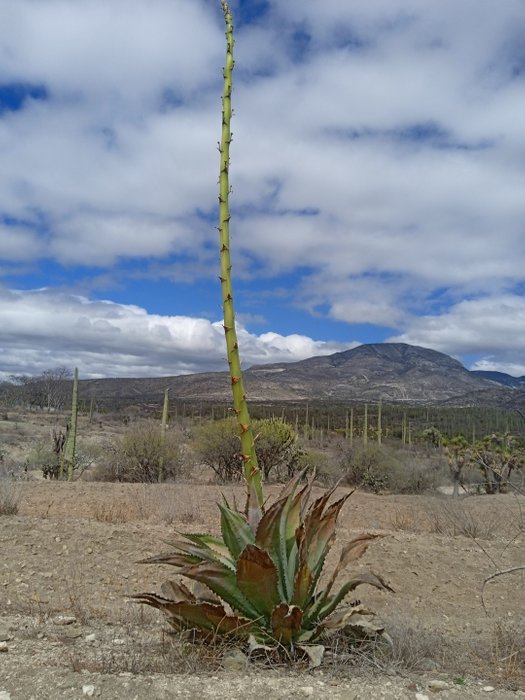
Planta de Agave emitiendo su espiga/Agave plant emitting its spike
Estación de la reproducción
Por último, una de las adaptaciones que más me impresiona es el hecho de que muchas especies de zonas áridas florecen durante el período seco. Esta adaptación es impresionante para mí porque a primera vista parece no tener sentido. ¿Por qué desarrollar adaptaciones para proteger el agua, y luego producir estructuras que demandan grandes cantidades de agua para su mantenimiento? Y aquí viene lo verdaderamente alucinante. Haciendo esto, se garantizan dos cosas. En una etapa de tanta escasez la producción de néctar atrae gran cantidad de animales que pueden actuar como polinizadores y de esta manera se maximiza la probabilidad de producir descendencia. Y por otro lado, la formación de fruto ocurre previa a la época de lluvias. Con ello, el momento para la dispersión de las semillas coincide con la época de lluvias, que es cuando las semillas tienen mayor probabilidad de sobrevivir en un ecosistema tan estresanteReproductive season
Finally, one of the adaptations that impresses me the most is the fact that many arid zone species flourish during the dry period. This adaptation is impressive to me because at first glance it seems to make no sense: why develop adaptations to protect water, and then produce structures that demand large amounts of water for their maintenance? And here comes the truly mind-blowing part. By doing this, two things are guaranteed. At a time of such scarcity, nectar production attracts large numbers of animals that can act as pollinators, thus maximizing the probability of producing offspring. On the other hand, fruit formation occurs prior to the rainy season. Thus, the time for seed dispersal coincides with the rainy season, which is when seeds are most likely to survive in such a stressful ecosystem.
Representación ex situ de un paisaje de desierto/Ex situ representation of a Desert landscape





